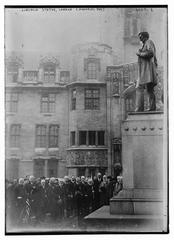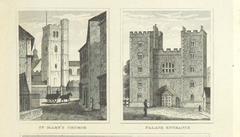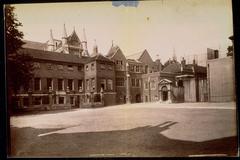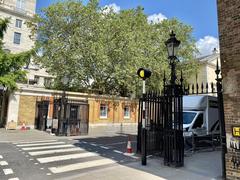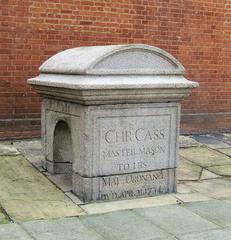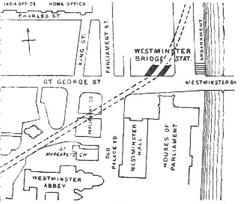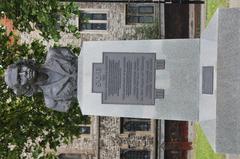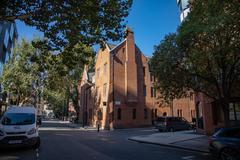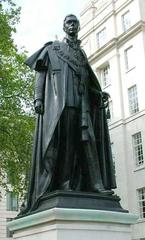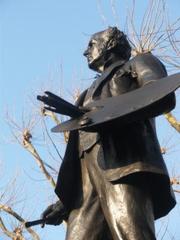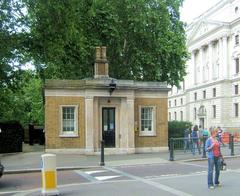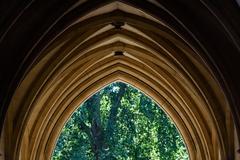The Deanery And Sub Dean'S Residence With The Jericho Parlour
Deanery and Sub Dean’s Residence Jericho Parlour Kingston Upon Thames: Visiting Hours, Tickets, and Historical Sites Guide
Date: 14/06/2025
Introduction
Kingston upon Thames, a town renowned for its royal and ecclesiastical heritage, offers visitors a wealth of historic sites—chief among them the Deanery and Sub Dean’s Residence with the Jericho Parlour. Dating back to the late 14th century, this architectural complex encapsulates centuries of religious, civic, and social evolution (Historic England; Southwark Anglican). This guide is crafted for history enthusiasts, architecture admirers, and travelers keen to explore Kingston’s layered past. Here, you’ll find detailed historical context, architectural insights, and all the practical information needed to plan your visit—including opening hours, ticketing, accessibility, and nearby attractions (Kingston Council).
Kingston’s significance as a coronation site for Anglo-Saxon kings and its enduring civic identity further enrich the context for understanding the Deanery’s role within the town (Kingston Heritage; A Lady in London). Visitors can also explore complementary sites like the Market Place, Clattern Bridge, and All Saints Church, each contributing to Kingston’s unique story (Secret LDN).
Additionally, this guide distinguishes Kingston’s Deanery from the similarly named ecclesiastical residences at Westminster Abbey in London, clarifying their separate histories and visitor experiences (Westminster Abbey).
Contents
- Overview of the Deanery and Sub Dean’s Residence with the Jericho Parlour
- Medieval Foundations and Architectural Evolution
- Kingston’s Ecclesiastical and Civic Importance
- Notable Features: The Jericho Parlour
- Planning Your Visit: Hours, Tickets, Accessibility
- Nearby Attractions and Visitor Tips
- Special Events and Experiences
- FAQs
- Preservation and Heritage
- Visiting the Deanery Kingston: Practical Information
- Historic and Architectural Significance
- Visitor Planning: Hours, Tickets, Accessibility
- Guided Tours, Events, and Photography
- FAQs
- The Deanery and Sub Dean’s Residence at Westminster Abbey
- Historical Background and Features
- Visiting Information and Access
- Notable Events and Residents
- Cultural Context and FAQs
- Kingston Upon Thames: History, Visitor Information, and Top Attractions
- Historical Overview
- Urban and Architectural Highlights
- Culture, Community, and Practical Visitor Guidance
- Amenities and Local Experiences
- FAQs
- Summary, Recommendations, and Further Reading
The Deanery and Sub Dean’s Residence with the Jericho Parlour, Kingston upon Thames
Medieval Origins and Architectural Evolution
Constructed around 1370, the Deanery and Sub Dean’s Residence originally served as the Abbot’s Lodging, underscoring Kingston’s status as a religious and administrative center in the Middle Ages. The site’s oblong courtyard, tierceron-vaulted passages, and stone mullioned windows are emblematic of medieval craftsmanship. Over the centuries, the complex was expanded, most notably with the addition of the Jericho Parlour in the early 16th century—a remarkable example of Tudor architecture (Historic England).
Subsequent modifications include classical pedimented dormers and attics, battlemented facades, and neoclassical interiors, each reflecting changing tastes and uses from the 17th to 19th centuries. Post-World War II restoration of the west range demonstrates ongoing preservation (Historic England).
Kingston’s Ecclesiastical and Civic Importance
Kingston upon Thames has played a pivotal role in English history since at least 838 A.D., when King Egbert held the Great Council here (A Lady in London). As the coronation site for at least seven Anglo-Saxon kings, its royal legacy is commemorated by the nearby Coronation Stone (Kingston Heritage). The Deanery stood at the heart of this activity, linking religious, civic, and ceremonial life.
The Jericho Parlour: A Tudor Treasure
The Jericho Parlour, built in the early 16th century, functioned as a private meeting space within the ecclesiastical residence. Its preservation provides insight into Tudor domestic and institutional life in Kingston (Historic England).
Planning Your Visit: Hours, Tickets, and Accessibility
- Opening Hours: Tuesday–Sunday, 10:00 AM–4:30 PM. Closed Mondays and major public holidays.
- Tickets: £7 (adults), £5 (seniors/students), free for children under 12. Available online or at the entrance.
- Guided Tours: Weekends at 11:00 AM and 2:00 PM.
- Accessibility: Wheelchair accessible with ramps and accessible restrooms. Assistance dogs welcome.
- Transport: 10-minute walk from Kingston railway station; served by multiple bus routes.
Nearby Attractions and Visitor Tips
Enhance your visit by exploring:
- Kingston Market Place: Historic and vibrant market square.
- Clattern Bridge: 12th-century medieval bridge.
- All Saints Church: Grade I listed, with a 17th-century marble font and heritage gallery (A Lady in London).
- Riverside Walks: Enjoy the Thames and local cafes.
Special Events and Visitor Experiences
Look out for seasonal events such as medieval-themed tours and art exhibitions. The courtyard and gardens offer beautiful photography opportunities, especially in spring and autumn.
Frequently Asked Questions (FAQ)
- Are guided tours available? Yes, on weekends at 11:00 AM and 2:00 PM.
- Is the Deanery suitable for children? Yes, with educational materials and family-friendly activities.
- Can I take photos? Yes, without flash.
- Is the site accessible? Yes, with ramps and accessible restrooms.
Preserving Kingston’s Heritage
The Deanery’s Grade I listing ensures ongoing conservation to protect its historical features while meeting modern accessibility needs (Historic England).
Visiting the Deanery Kingston: Hours, Tickets & Historic Highlights
Historic and Architectural Significance
Kingston’s Deanery and Jericho Parlour reflect the town’s status as a royal and ecclesiastical center since Saxon times, with coronations of several early English kings (Local Histories). The architecture spans medieval stonework, Tudor and Georgian brick, and later Victorian and Edwardian elements. The Jericho Parlour is a rare example of a private clergy retreat, illustrating the building’s evolving purpose (Kingston Council: Listed Buildings).
Visitor Planning: Hours, Tickets, Accessibility
- Opening Times: Tuesday–Sunday, 10:00 AM–4:00 PM. Closed Mondays and public holidays.
- Tickets: Free admission; donations welcome for conservation.
- Booking: Guided tours on weekends; book in advance via the Kingston Heritage website.
- Accessibility: Ramps and accessible restrooms; contact visitor center for tailored assistance.
Guided Tours, Events, and Photography
Regular tours provide historical and architectural insight. Special events, including reenactments and lectures, occur throughout the year—check the official calendar.
Photography is permitted in public areas (no flash or tripods indoors).
Frequently Asked Questions (FAQ)
- Is entry free? Yes, but donations are appreciated.
- Can I book a private tour? Yes, arrange in advance.
- Are children welcome? Yes, with educational activities.
- Are pets allowed? Only assistance dogs.
- When is the best time to visit? Weekdays and mornings are quieter; weekends offer tours and events.
The Deanery and Sub Dean’s Residence at Westminster Abbey
Historical Background and Features
Located at Broad Sanctuary, London, the Deanery and Sub Dean’s Residence at Westminster Abbey are among the oldest continuously occupied residences in the city, with origins in the medieval abbot’s house (Cheyneygates). The Jerusalem Chamber and Jericho Parlour were built in the 14th–16th centuries, adorned with Tudor linenfold panelling and stained glass featuring Abbot Islip’s rebus (Westminster Abbey History; Wikipedia: Westminster Abbey). The Sub Dean’s Residence occupies part of the monastic dormitory and refectory (British History Online).
Visiting Information and Access
- Public Access: Interiors are private; no regular visiting hours or tickets.
- Exterior Viewing: Facades and gardens can be appreciated from Broad Sanctuary and Dean’s Yard (Flickr Group Discussion; Wikimedia Commons).
- Special Tours: Occasionally offered—check the Westminster Abbey official website.
- Accessibility: Close to Westminster and St. James’s Park Underground stations.
- Photography: No interior photography, but official images are available for purchase (Westminster Abbey History).
Notable Events and Residents
The Jerusalem Chamber has hosted significant historical events, including the death of King Henry IV and meetings of the King James Bible translation committee (British History Online). The Deanery has housed influential figures in English religious and political life.
Cultural Context and FAQs
The tradition of naming rooms after biblical places, such as Jericho and Jerusalem, reflects ecclesiastical symbolism (Westminster Abbey History).
- Can I visit the interiors? No, except possibly on special open days.
- Are guided tours available? Occasionally; check the Abbey website.
- Where to learn more? Abbey tours and official photographs provide context.
Kingston Upon Thames: History, Visitor Information, and Top Attractions
Historical Overview
Kingston’s roots go back over a millennium, with its first recorded mention in 838 CE and a legacy as the coronation site for several Saxon kings (Kingston Tour Guides; Southwark Anglican). The town remained a royal and ecclesiastical center through the medieval and post-Norman periods.
Urban and Architectural Highlights
The townscape blends medieval, Georgian, Victorian, and modern elements. The Ancient Market Place has been a commercial hub since the 13th century (Secret LDN). Notable landmarks include the Market House, the River Thames, and All Saints Church, which features a heritage gallery after a significant restoration (Southwark Anglican).
Culture, Community, and Practical Visitor Guidance
Kingston boasts regular festivals, a lively arts scene, and community events. The Kingston Museum documents the town’s evolution (Secret LDN). Kingston Tour Guides offer free walks covering historic areas and specialized themes (Kingston Tour Guides). In 2025, Kingston celebrates 1,100 years since Athelstan’s coronation with a major cultural festival (Kingston Online).
Amenities and Local Experiences
Shopping ranges from the Bentalls Centre to riverside markets, while riverside walks and historic pubs enhance the visitor experience. Canbury Gardens and other green spaces offer relaxation.
FAQs
- All Saints Church hours? Daily 9:00 AM–5:00 PM; free entry.
- Are guided tours free? Yes; donations appreciated.
- Is Kingston accessible? Yes, including for wheelchair users.
- How to get to Kingston? 30 minutes by train from London Waterloo.
- Kingston Museum entry? Free.
Summary and Visitor Recommendations
The Deanery and Sub Dean’s Residence with the Jericho Parlour in Kingston upon Thames represent a living history, from medieval ecclesiastical governance to Tudor architecture (Historic England; Kingston Council). While the Deanery at Westminster Abbey is more restricted, Kingston’s site is accessible and welcoming, supported by guided tours and family-friendly activities (Westminster Abbey). Kingston’s rich cultural offerings—including vibrant markets, historic churches, and riverside walks—complement the Deanery experience (Kingston Tour Guides; Secret LDN). For enhanced exploration, the Audiala app provides interactive guides and up-to-date events (Audiala).
Plan your visit, join a guided tour, and immerse yourself in the stories and architecture that define Kingston’s centuries-old heritage.
Sources and Further Reading
- Historic England: Deanery Kingston upon Thames
- Kingston Council: Listed Buildings
- Westminster Abbey: Jerusalem Chamber History
- Kingston Tour Guides
- Kingston Heritage
- A Lady in London
- Secret LDN: Things to Do in Kingston
- Kingston Tour Guides - Official Site
- Southwark Anglican: All Saints Kingston
- Westminster Abbey Official Site
- Audiala App
